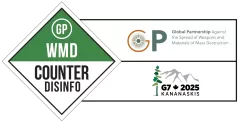DISINFORMATION TACTIC SPOTLIGHT
DEVELOPING A TAXONOMY
The Global Partnership Against the Spread of Weapons and Materials of Mass Destruction (GP) seeks to understand and counter Russian state-sponsored or state-adjacent disinformation across Chemical, Biological, Radiological, and Nuclear (CBRN) threats, in support of GP Member efforts. As part of this effort, the Johns Hopkins Center for Health Security (JHCHS) is developing a taxonomy of Russian state-sponsored/state-adjacent disinformation about CBRN threats.
This taxonomy leverages a systematic and rigorous analysis of over 300 news media items collected from the EUvsDisinfo Database. The taxonomy maps common narratives, tactics, and themes associated with pro-Kremlin CBRN disinformation, highlighting recurring patterns that can then be countered proactively to build resilience. The taxonomy also provides the scientific foundation for subsequent in-depth analyses of specific narratives and themes frequently identified through our mapping process, in the form of Tactic Spotlights.
OVERVIEW
METHODOLOGY
To establish a robust evidence base for this analysis, the research team conducted three dedicated systematic searches for news media items containing weapons of mass destruction (WMD) disinformation: one for biological weapons-specific content, a second for chemical weapons-specific content, and a third for radiological and nuclear weapons-specific content. Searches were conducted on the EUvsDisinfo Database, which is a collection of pro-Kremlin disinformation claims managed by the European External Action Service. Each search was conducted using search terms available on the database website. Searches were conducted between November 2023 and March 2024 and yielded 465 total results in the form of distinct disinformation “claims.” All news media items in which such claims were propagated were reviewed, with exclusion of items based on the following criteria: any language except English, Russian and Ukrainian, video or radio format, not related to the threat category of interest, and non-working links. The final biological weapons-related sample consisted of 199 news media items, while the chemical weapons-related sample and radiological/ nuclear-related sample consisted of 62 and 84 news media items, respectively. All news media items were published between 2017 and 2024.
The research team then developed a preliminary coding framework of disinformation subjects, targets, narratives, and tactics based on existing literature on disinformation, risk perception, and political rhetoric. The coding framework was refined through pilot testing and iterative revision. This framework was adapted to each sample, resulting in three final codebooks (one for each threat category). Each relevant codebook was then used to code the corresponding sample. All news media items were coded independently by two researchers to ensure high levels of reliability. Researchers met to discuss and adjudicate any coding discrepancies through a process of negotiated agreement, ensuring rigorous application of the codebook. The recurring subjects, targets, narratives, and tactics across each threat category were then organized into a disinformation taxonomy. Below is a graphical representation of selected themes from all three samples. Note: the size of the boxes does not correspond to the frequency with which countries, organizations, or themes were discussed in the sample.
TAXONOMY


SELECT TACTIC SPOTLIGHTS
The “references to past crises” tactic links current CBRN threats (real or falsely alleged) with historical disasters or atrocities such as genocide, the Chornobyl disaster, or the Holocaust. It is designed to evoke a strong emotional response among readers and discredit opponents of Russia by accusing them (implicitly or explicitly) of repeating historical injustices or tragedies.
The “authoritative” sources tactic is used to provide a false appearance of legitimacy or expert backing. However, these sources may be fake, taken out of context, paid by/part of the originator of the disinformation, or have expertise in a separate area altogether. This tactic makes it difficult to differentiate between legitimate news coverage and disinformation campaigns.
The “distraction and misdirection” tactic points to (real or falsely alleged) CBRN activity and threats, such as weapons use, attacks on facilities, or emerging dangers. It is designed to cause confusion about what may be happening on the ground, justify potential use of weapons, and/or direct attention away from a country’s own CBRN activities or actions.
Portraying States and Entities as Puppets
The “portraying states and entities as puppets” tactic is used to imply that a foreign power exercises control over a country or entity, thereby discrediting it and its supporters. This tactic is often employed alongside false claims of CBRN development or use, including claims that Ukraine’s development or use of such weapons is controlled or directed by the United States and the broader “West.” This tactic also discredits and undermines multilateral institutions such as the Organization for the Prohibition of Chemical Weapons (OPCW), the International Atomic Energy Agency (IAEA), and United Nations by framing them as puppets of “the West.”
The “framing Russia as a savior” tactic represents Russia’s attempt to commend its own actions, framing them as necessary to ensure global peace and security. By drawing attention to alleged CBRN and other security threats that purportedly require Russian intervention, this tactic is designed to legitimize Russia as a responsible international actor and justify its aggression in Ukraine.
Interested in learning more about these disinformation tactics?
Visit gpwmdcounterdisinfo.com/policy-briefs/#tactic-spotlights to explore the full tactic spotlights, discover how these tactics are employed within the CBRN information space, and take actionable steps to counter them.
January 2025
